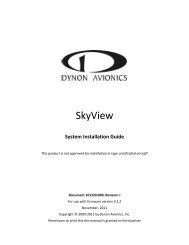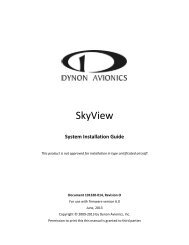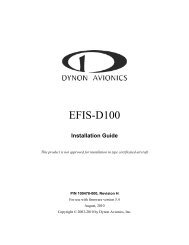EFIS-D60 Installation Guide - Dynon Avionics
EFIS-D60 Installation Guide - Dynon Avionics
EFIS-D60 Installation Guide - Dynon Avionics
Create successful ePaper yourself
Turn your PDF publications into a flip-book with our unique Google optimized e-Paper software.
AppendixBoom mountPLUMBINGNOTE: Because the pitot and AOA plumbing tubes have not been annealed, they work-hardenrapidly when manipulated. Make gentle bends, and only bend any given section once.After mounting the probe, route the pitot and AOA lines from the probe to your <strong>EFIS</strong>-<strong>D60</strong>. Thetube closest to the snout is the pitot line, while the tube in the rear is the AOA line. There is nostatic source on the probe.After mounting the probe, install adapters to connect the 3/16 plumbing lines from the probe towhatever plumbing lines run back to the <strong>EFIS</strong>-<strong>D60</strong> in your aircraft (AN 919-2D for 3/16 to ¼).We strongly recommend using aircraft grade fittings such as standard AN fittings. Make sure theplumbing lines do not chafe or interfere with any aircraft control systems.PRESSURE CHECK<strong>Dynon</strong>’s pitot design deliberately has a pin-sized leak hole in each of the two tubes to permitdraining any moisture which might accumulate inside. These holes are located in the middle ofthe tube at the bottom. Plugging these holes does not guarantee a pneumatic seal (although one issometimes present). The leak that may exist does not affect the performance of the probe. Youwill, however, need to take it into account when doing pressure/leak tests on your pitot systemCALIBRATIONCAUTION: It is your responsibility to fly your plane safely while performing anyconfiguration or calibration in flight. The best scenario would include a second person toperform any necessary steps on the <strong>EFIS</strong>-<strong>D60</strong>.Once you are flying straight and level at a safe altitude for stalls, enter the SETUP > AOACALmenu. While the AOACAL menu is displayed, oscillate the aircraft between ± 5° pitch 4 times atfast cruise airspeed. During this maneuver the <strong>EFIS</strong>-<strong>D60</strong> records the lowest angle of attack thatyou usually see during flight. You do not need to push any additional buttons before starting thismaneuver.Refer to the list below of the stalls recommended to complete the user calibration. The generalidea is to record stall data to find the lowest angle of attack stall. The list we have suggested is astarting point and produces a good calibration under most circumstances. However, if there are<strong>EFIS</strong>-<strong>D60</strong> <strong>Installation</strong> <strong>Guide</strong> 5-13
















